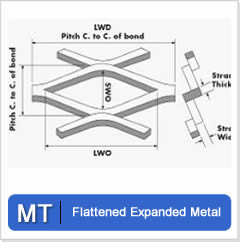Expanded Metal is an extraordinarily versatile material - one with thousands of uses. It comes in three basic types, and it has four primary areas of application.
Basic types are raised (or standard), flattened and architectural (or decorative) meshes. The major areas of use are for enclosure, protection, support and decoration.
Expanded metal products are produced from solid sheets or plates of carbon, galvanized and stainless steel, as well as aluminum and a variety of alloys of copper, nickel, silver, titanium and other metals.
Standard Expanded Metal: Expanded metal as it comes off the machine. The strands and bonds are set at a uniform angle to the plane of the sheet. This adds strength and rigidity, allows air circulation, and distributes the load on the metal to the supporting frames as well as making a skid resistant surface.


Flattened Expanded Metal: Manufactured by passing the standard expanded metal through a cold roll reducing mill parallel to the LWD. By flattening the sheet, the bonds and strands are turned down to produce a smooth and flat surface, reducing the overall thickness and elongating the diamond pattern (LWD). Cross roll flattening is done by passing the expanded metal sheet through a cold roll reducing mill parallel to the SWD. The result is the same except the diamond pattern SWD is elongated.


Decorative Expanded Metal: Specially designed expanded metal for use in architectural and decorative applications. These design can be used to provide privacy and to control light and air while allowing visibility. Sun screens, room dividers, and building facades are only a few of the possible design possibilities. Available in carbon steel, aluminum and other alloys in a wide range of patterns and gauges. Most of these patterns are produced on a special order basis only.


Carbon Steel Expanded Metal Specification
Stainless Steel Expanded Metal Specification
Aluminum Expanded Metal Specification




